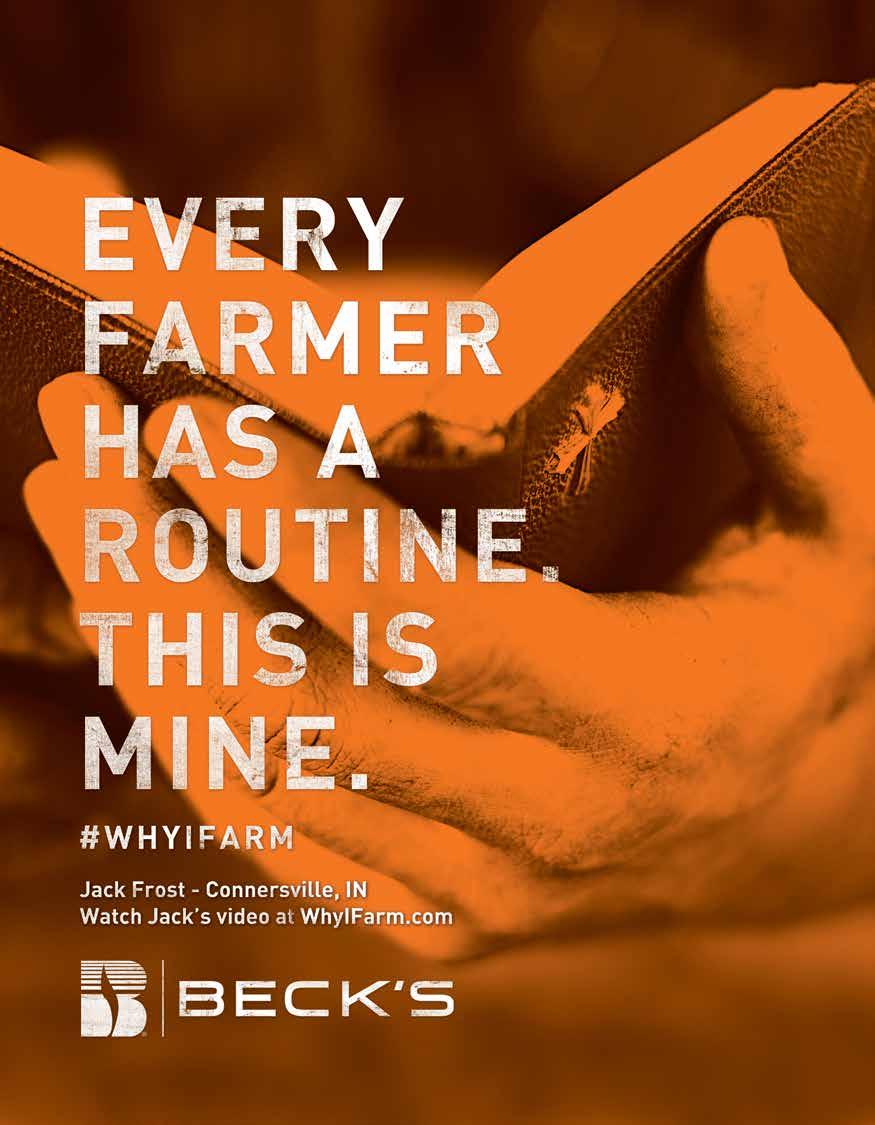

Kicking Off Harvest
Ohio Stadiums Incorporate Soy-based Turf on Playing Fields p.20
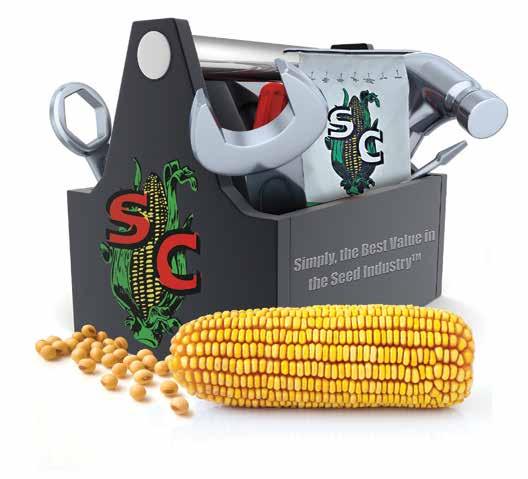

PROVEN PERFORMANCE
The only Eastern Corn Belt based Seed Company with 4 National and 25 State Winners in the NCGA Yield Contest since 2008.
REGIONAL GENETICS
Genetics developed, tested and bred exclusively for the Eastern Corn Belt’s unique growing conditions and soil types.
REGIONAL TESTING
Over 50,000 yield plots, tested at 100+ testing locations across the Eastern Corn Belt.
REASONABLE PRICING
A fair, honest and reasonable price the first time.
TODD SHIELDS Salem, Indiana

Ohio Soybean News


Perspective

Jerry Bambauer
Ohio Soybean Association Chairman
Auglaize County soybean farmer
A Letter From the Chairman
Greetings from Auglaize County!
My name is Jerry Bambauer and I’m excited to assume the position of Chairman of the Ohio Soybean Association (OSA). I previously served as President and currently serve as an American Soybean Association (ASA) board representative. I have had a passion for agriculture my entire life and grow soybeans, corn and wheat on our farm in New Bremen. As a soybean farmer, I understand the importance of remaining proactive on policy issues affecting soybean farmers so the industry so near and dear to my heart continues to thrive.
The OSA Board of Trustees recently elected officers for 2014-2015 during the September board meeting. Together, we are responsible for the implementation of board policies and procedures so that the soybean industry is heard at both a state and national level.
I would like to introduce your new elected officers for 2014-2015:
President: Tommie Price of Putnam County
First Vice President: Adam Graham of Logan County
Vice President: Jeff Roehm of Highland County
Treasurer: Todd Hesterman of Henry County
Secretary: Allen Armstrong of Clark County
American Soybean Association Board Representative: Jeff Sollars of Fayette County
Lastly, it is no secret that nutrient management has been causing a buzz around the state. While agriculture is not the only source of the problem, there are several ways we as the agriculture community are taking action. I encourage you to read a letter from several Ohio agriculture commodity groups on page 6 so we can all remain on the same page and move forward. With practices to reduce runoff and collaboration among stakeholders, we can make a difference.

SOYBEAN ASSOCIATION
President
Tommie Price, Putnam County
First Vice President
Adam Graham, Logan County
Vice President
Jeff Roehm, Highland County
Treasurer
Todd Hesterman, Henry County
Secretary
Allen Armstrong, Clark County
Chairman
Jerry Bambauer, Auglaize County
Trustees
John Buck, Marion County
Amy Sigg Davis, Warren County
Dave Dotterer, Wayne County
Caitlyn Heimerl, Licking County
James Heimerl, Licking County
Mike Heffelfinger, Van Wert County
Chad McIlvaine, Ross County
Lane Osswald, Preble County
Bruce Simmons, Medina County
Jeff Sollars, Fayette County
Industry Affiliates
Kathy Alvarez, Bunge N.A.
Bill Tom, Trupointe Cooperative
Bob Slicker, Stark County
American Soybean Association Board
Representatives
Bret Davis
Jerry Bambauer
Jeff Sollars
Staff Credits
Adam Ward – Publisher
Jennifer Coleman – Editor
Katie Bauer – Staff Writer
Judy Brent – Production Manager
Carol Locker – Designer
Ohio Soybean News is published six times a year by the Ohio Soybean Association, 918 Proprietors Rd., Suite A, Worthington, OH 43085 Phone: 614-476-3100. For address corrections contact Ohio Soybean News at 918 Proprietors Road, Suite A, Worthington, Ohio 43085. Web address: www.soyohio.org E-mail: cdeboard@soyohio.org
Comments and statewide news articles should be sent to the above address. Advertising space reservations must be made by the first of the month preceding publication. In consideration of the acceptance of advertisement, the agency and the advertiser must, in respect of the contents of the advertisement, indemnify and save the publisher harmless against any expense arising from claims or actions against the publisher because of the publication of the content of the advertisement.
For Advertising Information Call: Tom Shearing Advertising Sales Manager Phone: 585-476-2426
EVERY DROP OF BIODIESEL DRIVES MORE VALUE FOR YOUR SOYBEANS.
2 BILLION GALLONS OF BIODIESEL
WERE PRODUCED NATIONALLY FROM SOYBEANS IN 2013, A NEW RECORD.
62,000 JOBS ACROSS 200 BIODIESEL PLANTS NATIONALLY.

This represents a growing component of the annual U.S. on-road diesel market of about 35-40 billion gallons. Consistent with projected feedstock availability, the industry has established a goal of producing about 10% of the diesel for the transportation market by 2022. • There are currently about 200 biodiesel plants across the country — from Washington state to Iowa to North Carolina — with registered capacity to produce

some 3 billion gallons of fuel.
• The industry is supporting more than 62,000 jobs, generating billions of dollars in GDP, household income and tax revenues. • OSC has worked closely with the National Biodiesel Board to drive development of additional uses for biodiesel. One example: home heating fuel. New York City is already the nation’s largest municipal user of biodiesel and recently implemented a 2% biodiesel blend mandate on heating oil.
Building Membership and Grassroots Advocacy









Like all Ohioans, farmers care about the quality of Ohio’s water and have made advancements in practices to reduce nutrient loss from farm fields. However, the recent drinking water situation in Toledo has created an increased sense of urgency and focus on agriculture’s contribution to this challenge.
We know that agriculture is not the only source of this problem and there is less fertilizer used on Ohio farms today than ever before. We applaud the efforts of Ohio farmers who have stepped up in recent years to implement practices to reduce runoff. Yet the severity of this situation cannot be understated and agriculture is and will continue to be in the crosshairs. Our work must continue.
Getting Answers, Taking Action
The Ohio Corn and Wheat Growers Association, Ohio Corn Marketing Program, Ohio Small Grains Marketing Program, Ohio Soybean Association and Ohio Soybean Council have been partnering for the past two years to represent your interests to researchers, legislators, media and local communities. Our actions include:
• Contributing primary funding to a $1 million research project with The Ohio State University and U.S. Department of Agriculture (USDA) to conduct edge of field runoff tests. Thanks to an additional $1 million grant from USDA, this $2 million project will help determine how dissolved phosphorus is getting into waterways and the best management practices to keep it on the fields where it belongs. The results of this critical research will be used to update and revise the P Risk Index to ensure that Ohio farmers have current and comprehensive information about managing dissolved phosphorus.
• Working with legislators on Senate Bill 150 which will require Ohio farmers to be certified to apply commercial fertilizer and has provisions for revoking the certification for bad actors. The training and certification process is expected to begin before the end of 2014.
• Giving grain farmers a public voice by creating more than 100 opportunities for farmer spokespeople to share their perspective on water quality issues with print, radio and television media.
Thanks to the foresight of our farmer-led boards, your corn, soybean and wheat organizations were able to quickly respond to media requests for information and farmer spokespeople during the Toledo water crisis We will continue to respond to interview requests, submit editorials, write letters to the editor and have face-to-face meetings with reporters to tell them agriculture’s story. Another priority of our organizations is working with legislators and government agencies to promote long-term, science-based solutions.
Water is essential to us all and the questions about agriculture’s contribution to this problem will continue. We encourage you to keep doing the absolute best that you can on your farm and in your communities to help keep the waters of Ohio clean. With the right actions, collaboration with other stakeholders and speaking up to tell our story, Ohio farmers can make a difference.

Jerry Bambauer
Ohio Soybean Association

Patrick Knouff
Ohio Soybean Council

John Hoffman
Ohio Small Grains Marketing Board

John Linder
Ohio Corn Marketing Board

Brent Hostetler
Ohio Corn & Wheat Growers Association
Building Membership and Grassroots Advocacy
Best Management Practices to Keep Phosphorus on the Field
Phosphorus Rate, Application and Timing
Avoid overloading soils.
Avoid winter application.
Avoid untimely surface application.
Soil test and follow Tri-State fertilizer recommendation. Where soil test levels are above 40 ppm Bray P1 or 58 ppm Mehlich III-ICP, do not apply additional phosphorus in the corn-soybean rotation. These levels require no additional fertilizer, according to the Tri-State fertilizer recommendations. Fertilizing soils testing above these levels increases risk of P in runoff and tile drainage.
Eliminate surface application of manure or fertilizer to frozen or snowcovered �ields. Frozen ground is ground that is frozen to the degree that tillage is not possible. Surface applied manure or fertilizer is subject to runoff events that may occur before the ground thaws and allows nutrients to bind to soil.
Surface applications of phosphorus are subject to higher loss if runoff producing rainfall events happen close to application. Placement of nutrient below the surface of the soil reduces loss. If tillage is planned in the crop rotation, P applications should be applied prior to the tillage and till before a rain event. Full width tillage has the potential to increased soil erosion and total phosphorus losses. New placement tools or strategies need to be implemented that place P below the surface with minimal soil disturbance. Until these tools become available, use banded application or the minimal amount of tillage to mix nutrient in the soil.
Farm and Field Features
Minimize erosion.
Slow the movement of water.
Appropriate conservation practices should be implemented to minimize erosion. Maintain 30% cover as crop residue/cover crop. Filter strips, grassed waterways and water diversion structures are appropriate tools.
Surface water �lows from �ields directed to tile via standpipes should be converted to blind inlets. As risk loss potential increases for a �ield, consideration should be given for edge of �ield treatments which control water movement or treat water as it is leaving the site. Drainage water management control structures, in ditch treatments such as two stage ditches and other stream practices can reduce loading.
Know your �ield’s risk.
Strive to build soil quality.
Soil test P, �ield proximity to water and soil hydrologic class impacts edge of �ield losses of phosphorus. The NRCS Ohio P Risk index provides a risk of loss index and should be used as part of the development of a Nutrient Management Plan to assess the individual �ield risk.
Soil condition is a mitigating factor. Increasing the water in�iltration by reducing compaction and improving soil structure increase water retention, nutrient cycling, crop rooting capacity and crop yield.
Prepared by Dr. Steve Culman, Dr. Libby Dayton, Dr. Kevin King and Greg LaBarge.
Andy Wentling of Stark County Named Beck’s Young Farm Leader
By Katie Bauer
For many young farmers, operating the family farm isn’t their only job. They may be working off the farm, raising a family and participating in their community organizations. Some like Andy Wentling, a third generation farmer from Stark County, also find time in their busy schedules to take on leadership roles in agriculture.
Working by day as a Service Manager for the local Bobcat dealership, Andy is also part owner of Wentling Farms, LLC. Andy farms soybeans, corn, wheat and hay on 230 acres and works alongside his dad and brother where they farm a total of 1200 acres. Andy rented his first farm of 30 acres when he was 21 years old, then bought his first farm of 51 acres when he was just 23 years old. He currently rents the rest of his acreage that he has been able to obtain since he started farming.
Andy was recently chosen as the third quarter Beck’s Young Farm Leader, a program that recognizes young Ohio farmers who actively contribute to the community, as well as the entire agriculture community.
“Farmers and agriculture have a great story to tell on many fronts,” said Bruce Kettler, Director of Public Relations at Beck’s Hybrids. “Beck’s wants to support leadership development efforts that will allow young farmers like Andy to thrive and build their communities.”
Andy remains involved in the community by helping the local 4-H club set up for the Stark County Fair each year.
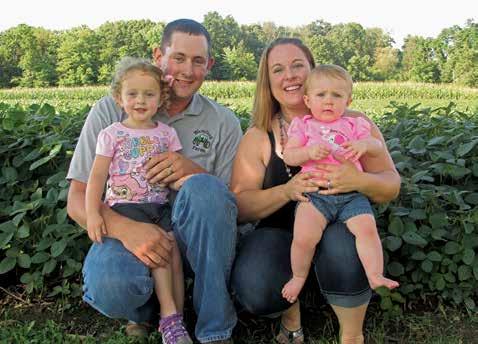
He has been very involved with the Stark County Farm Bureau, where he served on several committees and also served as president and vice president. At the state level, Andy and his wife, Tera, have been on the Young Agriculture Professionals Committee for the past two years, where they served as chairs in 2013.
“The main place that I held a leadership role was in Farm Bureau organizations,” said Andy. “I started out 6 years ago by joining the Stark County Farm Bureau Board where I became public policy chairman. As the public policy chair, I was able to attend Ag Day at the Capitol where we met with elected officials and discussed
current agriculture issues.”
As a graduate of The Ohio State University’s Agriculture Technical Institute (OSU ATI), Andy feels it’s important to give back to the school that provided him a foundation for his career success. As a result, Andy devotes time talking to current students about job opportunities available in the field of agriculture.
“I enjoy going to OSU ATI to talk to the students about what companies like Bobcat are looking for in terms of skills and qualifications to hire recent graduates,” said Andy. “In addition, I enjoy discussing a variety of careers in the agriculture industry especially in the animal

Andy Wentling, Beck’s Young Farm Leader, and his wife, Tera with their two children, Hannah (2) and Alivia (1) on their farm in Navarre, Ohio.
science, food science and several other related fields that all fit together and make agriculture successful.”
Andy enjoys being a Service Manager, but hopes to eventually farm full-time.
“I would like to see the farm continue so I am not the 3rd and final generation,” said Andy. “My heart will always be in agriculture.”
Like many industries, Andy believes there are both threats and opportunities.
“Herbicide-resistant weeds pose a threat to soybean yields throughout Ohio and the United States,” said Andy. “I make a conscious effort to implement production practices that manage herbicide resistant weeds such as no-till farming and using clover as a cover crop.”
Recent research shows that crop rotation, cover crops and other site-specific practices can provide positive, consistent returns.
One opportunity Andy has an interest in and sees as positive change happening is in the production of biodiesel and ethanol.
“There is a big push for renewable
resources,” said Andy. “With the increase of farm size and yield, there is great potential for biodiesel and ethanol to continue to increase.”
Whether it’s working past midnight during planting and harvest, spending time with his wife and daughters, working at Bobcat or telling his story; agriculture is a huge part of Andy’s life.
“I congratulate Andy on being chosen as a Beck’s Young Farm Leader,” said Jerry
Bambauer, Ohio Soybean Association (OSA) chairman and soybean farmer from Auglaize County. “OSA has made it a priority to advocate on behalf of Ohio soybean farmers and recruit farmers like Andy to be the face of the industry because of the commitment he showcases to the soybean industry in Ohio. OSA is proud to recognize young Ohio farmers and encourages other farmers to apply or nominate someone for the Beck’s Young Farm Leader program.”
2014 Beck’s Young Farm Leader Program
Apply or Nominate Someone Today!
Guidelines:
Growers must be between the ages of 21 and 45. Any soybean grower may apply for the Beck’s Young Leader Program; selected participants are required to have a current Ohio Soybean Association membership. Applicants are not required to grow Beck’s Hybrids products to be eligible to win.
Applicants should demonstrate an interest in pursuing leadership roles within the soybean industry.
Fall Herbicide Application
Fall herbicide treatments have become a fairly common practice for many no-till producers who recognize their value for managing certain tough winter weeds. The Ohio State University has been conducting studies on fall herbicide application since 1999. Over time, they have discovered several benefits to using a fall program combined with a residual spring program. Most notably, however, they have found that residual herbicides applied in the fall tend to disappear over the winter, so it does not add much value for a farmer to apply residuals in the fall.
4th Quarter Applications
Due: October 31, 2014
Apply online at www.soyohio.org/ becksyoungfarmleader
Nominate someone by contacting Adam Ward at award@soyohio.org
spend more than $8-$10 per acre on a fall herbicide program and should think about applying it toward the end of October through Thanksgiving. Farmers should then save some money to continue with a residual program in the spring.”
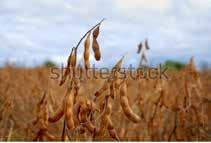
Mark Loux, extension specialist, weed science at The Ohio State University, recommends, “Farmers shouldn’t
A fall herbicide program ensures a relatively clean seedbed for farmers in the spring. Plants that overwinter are usually harder to burn down in the spring, so it is a good idea to get a jump on controlling them in the fall for a better start in the spring.
Managed by the Ohio Soybean Council and soybean checkoff, the Soybean Rewards Program helps Ohio soybean farmers increase productivity, yield and profitability by providing information and research related to premium opportunities, new varieties, disease and pest management and conservation practices.

SOY TALK
Making the Grade
Like explorers blazing a trail for future settlement, a soybean seed planted in the eld has endured an extremely arduous journey through years of research.
“Our goal is to release the ultimate variety that is better than what’s on the market right now, whether it is better yield, or disease or insect traits that aren’t currently available,” says Mycogen Seeds soybean breeder Dennis Schultze. “At any point in the yield testing phase, varieties that do not exceed what is currently on the market get thrown out.”
“Only about 0.2 percent of [soybean] lines ever become commercially available.”
Mycogen Seeds has a comprehensive and state-of-the-art soybean breeding program, complete with seven stations throughout the United States and Canada. There also are winter breeding programs in Puerto Rico and Chile.
Schultze says tens of thousands of new varieties are yield tested, but only about 0.2 percent, or one in 500 varieties, of those lines ever make it to become commercially available.
Soybean breeding is a ve- to six-year process. At every step, a potential variety must meet multiple requirements. “If you compare it to education, a soybean variety must get an A on every test to continue through the process,” Schultze adds. “For example, at the Minnesota breeding station, one of the characteristics we focus on is soybean cyst nematode resistance. Every variety is screened to make sure it has a marker for cyst resistance. If a plant does not, it is automatically discarded.”
After the lab and nursery testing is complete, varieties move to yield testing. In addition to yield, researchers look for characteristics such as disease tolerance and lodging resistance. Field evaluations are vital because they mimic what farmers are doing in their elds. This allows researchers to collect the information farmers need to make seed decisions.
“We can have new varieties in the hands of farmers in ve to six years,” Schultze says. “Fifteen years ago, it took twice as long. What Mycogen Seeds is doing from a breeding standpoint all boils down to the farmer and what works on his acres.”
Brought to you by:
Ohio Soybean Association Hosts 2014 Harvest Classic
The Ohio Soybean Association (OSA) recently hosted the 2014 Harvest Classic golf outing at Oakhaven Golf Course in Delaware, Ohio. The annual outing is held as a fundraiser for the OSA Political Action Committee (PAC). The OSA PAC provides the opportunity for individuals interested in the future of the soybean industry to contribute to the support of worthy candidates for federal and state office who believe, and have demonstrated their belief in, the priorities of soybean farmers.
Congratulations to this year’s winners which included Roger Tedrick, Jim Scheid, Dave Miller and Jim Ballengee.
Thank you to the 2014 Harvest Classic Sponsors!
Aimpoint Research LLC
Barrett, Easterday, Cunningham & Eselgroth LLP
Bunge NA
Cargill, Inc
Carl Graphics Company
Clean Fuels Ohio
DARCO Consulting Inc
DuPont Pioneer
Education Projects & Partnerships LLC
Event Marketing Strategies
Farmer, Lumpe & McClelland
FraizerHeiby
Great Lakes Hybrids
Hadsell Chemical Processing
Heritage Cooperative
Hudson Insurance
Ice Miller
KeyBank
Melamed Communications
Mulligan, Topy & Co
National Biodiesel Board
Ohio Bioproducts Innovation Center
Ohio’s Country Journal/Ohio Ag Net
Peter Cremer North America
Ohio Farm Bureau
Ohio Corn & Wheat Growers Association
Ohio Pork Producers Council
Ohio Poultry Association
Redwood Innovation Partners LLC
Seed Consultants
SMD Products Company
Trupointe Cooperative
Wilt Public Relations
USA Poultry & Egg Export Council
SOYBEAN ASSOCIATION


YOUR FIELDS NEXT.

Another advancement in soybean technology is on the horizon.


Jay Brooks
Roundup Ready Xtend ™ Learning Xperience Site Manager Ohio
The next game-changer from Asgrow® brand isn’t just closer to being available for your farm, it’s already proving itself in field research. Hear from an Asgrow expert on the latest high-yielding approach to weed control.
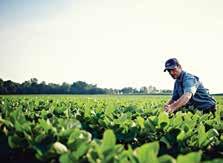
Q: What feature of Roundup Ready 2 Xtend ™ soybeans, pending regulatory approvals, are you most excited about?
A: Our Asgrow products are built on the Genuity® Roundup Ready 2 Yield® platform so farmers will still experience the same high yield potential and performance they’re used to seeing. The trait used in our Roundup Ready 2 Xtend™ soybeans will be highly effective. Because it’s bred into our elite germplasm, it will become a high-performing plant, and farmers will see the higher yields they are accustomed to from Asgrow.
Q: How is the Roundup Ready ® Xtend Crop System helping you achieve clean fields?
A: Because the Roundup Ready 2 Xtend™ soybeans will be tolerant to key herbicides – dicamba and glyphosate – it will give our farmers, upon regulatory approvals, a different mode of action to take care of tough weeds and protect their acres. We’ve seen some weed resistance to glyphosate move into the Ohio area from the south.
Q: Why will this system benefit farmers in your area?
A: Our high-yielding Asgrow soybean brand combined with this additional mode of action will offer Ohio farmers more output from their acres and will help to tackle the weedresistance issue. Farmers will be able to use these genetics and customize the application to their current programs.
Q: What are you most looking forward to about this system coming to market?
A: I have a lot of confidence in recommending this system to our farmers. We’ve had a lot of time to observe this system, and we’re excited about the performance of the system and the potential benefits to farmers that we’re seeing. It’s just one more innovative solution that Asgrow is bringing to market to benefit farmers.
“Our
high-yielding Asgrow soybean brand combined with this additional mode of action through the Roundup Ready ® Xtend Crop System will offer Ohio farmers more output from their acres and will help to tackle the weed-resistance issue.”


Catering to Soy Customers: Provide End Users With What They Need from U.S. Soybean Meal
By Ellen Blindt United Soybean Board
What do you look for as a soybean farmer when you select soybean varieties? Is it the yield potential? What about qualities such as standability, emergence and maturity? Is it their ability to withstand disease, pests or environmental conditions?
Project manager and nutritionist Sønke Møller, who purchases soybean meal for the Danish Pig Research Centre in Denmark, says the most important thing he looks for is quality.
“We prefer soybean meal with high protein levels, low content of trypsin inhibitors and good protein digestibility,” he says.
Møller says amino acid content is vital.

“The better the amino-acid profile, the better it is for the sow consuming the feed,” he explains. “Especially if the sow is lactating, then the optimal amino-acid content will increase milk production and will increase daily gain for the suckling piglet. Furthermore, high protein digestibility will improve feed conversion and daily gain for
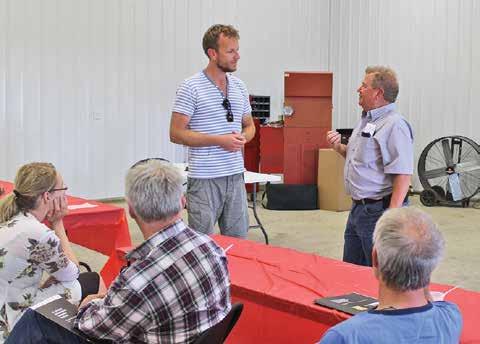
growing pigs.”
Møller studies the component quality of various feedstocks. The components determine the value of the feed, he says.
“We are analyzing the imported soybeans to Denmark for their aminoacid profile and protein content,” he says. “Depending on the profile, it will come in with higher or lower feed costs.”
Møller was part of a delegation from the Danish swine sector that visited the United States to learn more about U.S. soy-production practices. Among other sites, the group visited Ohio Soybean Council (OSC) board member John Motter’s farm in Jenera, Ohio.
Motter believes U.S. soybean farmers should select their seed based on the same criteria for quality that their customers use to decide which products to buy.
“Animal agriculture uses a lot of meal, whether that’s here in the United States or all the way over in Denmark, and they want to deal with the best protein and amino acids that we can provide them,” Motter says. “Whatever we can do to ensure that we are making strides to improve the composition of our soybeans, that is a great message to send back to all of our customers.”
A group from the Danish Pig Research Centre at John Motter’s Hancock County Farm.
Project manager and nutritionist Sønke Møller, who purchases soybean meal for the Danish Pig Research Centre in Denmark, visits with John Motter, Ohio soybean farmer and Ohio Soybean Council Board member.

Investing Checkoff Dollars
USSEC Agriculture

By Barry McGraw Director, Product Development & Commercialization, Ohio Soybean Council
The U.S. Soybean Export Council (USSEC) held its annual Qualified State Soybean Board (QSSB) training camp in the cities of Monterrey and Guadalajara, Mexico from August 3-8. The Ohio Soybean Council (OSC) is a member of USSEC and supports numerous international outreach efforts in order to increase the demand for U.S. soybeans. The focus of the trip was soybean processing, soy food research, soybased manufacturing, and aquaculture (i.e., fish farming), which utilizes soybean meal in most shrimp and fish diets. This year’s camp highlighted the Mexican market and included government and industry presentations, tours of importing and processing facilities, and a training session on working with Latin American businesses, among other relevant topics. Mexico consists of 31 states and one federal district; its capital is Mexico City. Mexico is an upper-middle-income economy, ranked by the
World Bank as the thirteenth largest globally in terms of gross domestic product (GDP). The climate ranges from tropical to arid, and the terrain consists of coastal lowlands, central high plateaus, deserts, and mountains up to 18,000 feet. Mexico is a main export destination for U.S. oilseeds, oilseed meal, and vegetable oil. In 2011, Mexico imported 3.4 million tons of soybeans; the U.S. was its major supplier.
On the USSEC visit, our first stops in Monterey were at ITESM (Instituto Tecnologico de Estudios Superiores de Mointerrey) University and Research Center and Ragasa, a seed processing facility. USSEC and ITESM are collaborating on a large program to utilize soybean meal at a 6 percent loading within the tortilla industry. If successful, and assuming a 30 percent market penetration, this program could increase the Mexican demand for U.S. soybean meal by approximately 13.7 million bushels annually.
Regasa is a major Mexican soybean processing facility. They are a diverse company that not only offers human food products, but also various feed products for cattle consumption. Ragasa is fully integrated when it comes to producing a100 percent soybean cooking oil that they both extract from the soybeans and then package and ship directly to grocery stores.
The group moved on to Guadalajara, where the most interesting stop was a family fish
Education Camp

farm (Alfredo Molina, proprietor) that raises Tilapia. We were highly impressed with the farm’s concern for the environment, pride in producing a quality product for human consumption, and expertise with up-to-date aquaculture technology. Numerous times, Mr. Molina expressed his appreciation for USSEC’s technical and business assistance. He feels that USSEC has provided the resources and opportunities for growth and sustainability. Mr. Molina’s fish farm utilizes a 30 to 35 percent soybean-meal-based diet and uses 2 ton of fish food every day.
Activities such as this QSSB training camp are key to USSEC’s and Ohio’s continued success in the Americas region. Providing growers and staff members with the opportunity to visit other markets is important to help their understanding of how USSEC increases demand for U.S. soy.
With a background in material engineering and not agriculture, this was a very eye-opening, educational visit for me that provided a better understanding of how U.S. and Ohio soybeans are being processed and utilized for human, animal, and fish consumption.
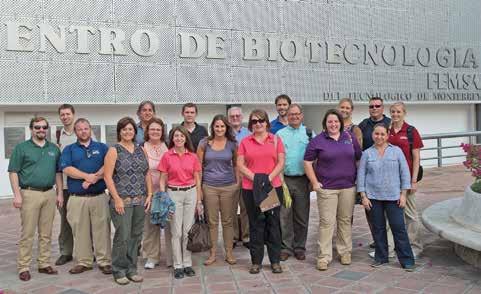
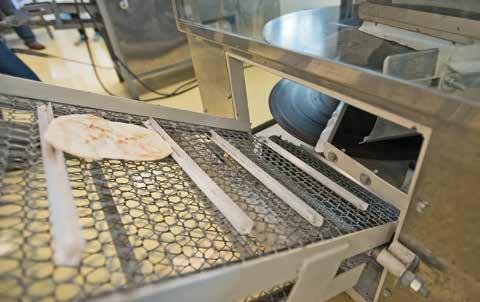
Adding a four to six percent mixture of defatted soybean flour (DSF) to corn tortillas and wheat flour has led to concrete results in lowering health risks of multiple diseases. Researchers found that adding six percent of DSF increased the tortilla’s overall protein by 25 to 30 percent. According to Sergio Serna Saldivar, head of the center for protein research development, “Soybeans are a gold mine in neutraceutical compounds that promote health benefits. The results of enhancing the nutritional value of these products are very impressive.”
Team participants received an overview of the Americas market from USSEC Regional Director – Americas Francisco de la Torre and also listened to a presentation from the Foreign Agricultural Service (FAS)’s Agricultural Trade Office (ATO) in Monterrey.
Workers prepare to feed a tank of tilapia at Molina Farm. Soybean meal is a major ingredient in the ration.

Investing Checkoff Dollars
Ohio Soybean Farmers Represented at 2014 Ohio State Fair
By Katie Bauer
Summer season around Ohio is filled with outdoor activities; state and county fairs being one of them. The Ohio State Fair, located in the heart of Ohio, otherwise known as Columbus, puts on one of the largest fairs in the United States. In fact, an estimated 916,724 people entered through the gates during the 12-day event this past summer. The Ohio Soybean Council (OSC) and soybean checkoff was a presenting sponsor of the 2014 Ohio State Fair and a presenting sponsor of the 2014 Junior Livestock Shows, the O’Neill Swine Building, Voinovich Livestock and Trade Center and Rabbit & Poultry Pavilion.
“Fairgoers were invited to learn more about Ohio soybeans and meet some of the men and women who grow them at the OSC display located on the fairgrounds in the Nationwide Donahey Ag and Hort building,” said Steve Reinhard, Chair of OSC’s communication’s committee and soybean farmer from Crawford County.
The Ohio State Fair was among the winners in Columbus Parent’s 2014 Best of Columbus Contest and as Best Seasonal Festival, was featured in Columbus Parent’s September 2014 issue.
“The Ohio State Fair is a prime opportunity to reach thousands of people from around the state and those who travel from outside the state,” said Patrick Knouff, OSC chairman and soybean farmer from Shelby County. “Through displays, handouts and conversations, we were able to reach thousands of fairgoers on the topic of biotechnology, farming systems, crop protection practices and how they all come together to create a product grown
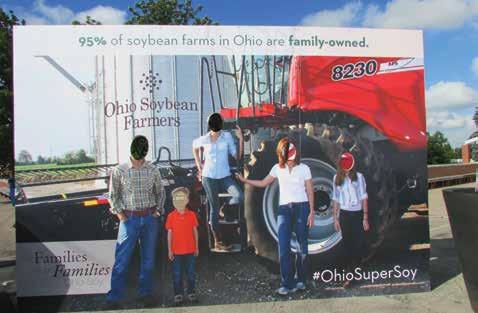
here in Ohio and around the United States.”
The Ohio Soybean Farmers’ booth included an interactive tractor simulator for fairgoers to get a feel for the equipment and technology soybean farmers use to grow crops. The booth also included soy bioproduct samples and demonstrations. Soy bioproducts, renewable products made with soybeans, are used in thousands of different household and industrial products and a popular item in the Ohio Soybean Farmers’ booth.
Soybean Day
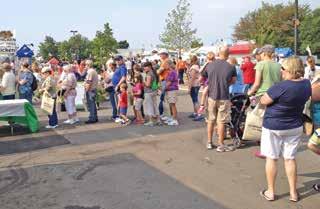
A line of people wait to check out the
fairgoers with grocery bags, literature, educational materials and answered questions about soybean farming in the state of Ohio.
On Saturday, August 2, OSC hosted Soybean Day.
Several OSC board members greeted
Ohio Pork Rib-Off
In addition to Soybean Day, seven of Ohio’s finest barbecue teams, from
Fairgoers were encouraged to take a photo with the Ohio Soybean photo board and upload to Twitter, using the hash tag Ohio Super Soy. One lucky winner won a Kroger gift card.
Ohio Soybean Farmers’ booth on Soybean Day, Saturday August 2nd.
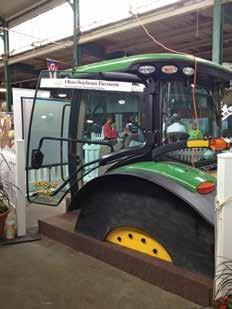
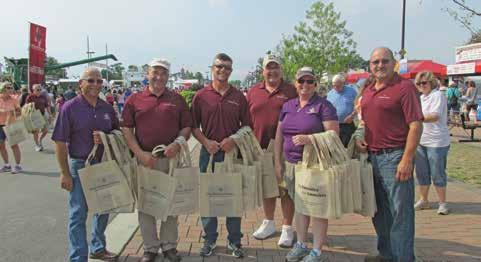
backyard chefs to major restaurateurs, gathered for the 18th annual Ohio Pork Rib-Off at the 2014 Ohio State Fair. This event invites teams to prepare both ribs and pulled pork that are evaluated by a judging panel for taste, tenderness and appearance.
This year’s contestants prepared their best pork for guest judges; Senator Cliff Hite, Ohio Senate District 1; Joel Riley, 610 WTVN; David White, Ohio Livestock Coalition; Steve Reinhard, OSC board member; and Virgil Strickler, General Manager, Ohio Expo Center.
Dale Minyo of Ohio Ag Net served as the competition emcee and announced the following award winners:
• Grand Champion Ribs: Smoke ‘Em if You Got ‘Em BBQ, Middleport, OH
• Reserve Champion Ribs: Tony’s Restaurant, Findlay, OH
• Grand Champion Pulled Pork: Hickory River Smokehouse, Tipp City, OH
• Reserve Pulled Pork: Team Baney-Q, Columbus, OH
• People’s Choice Award Winner: Wally’s Great American BBQ, Tiffin, OH

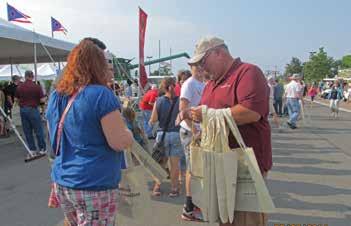
• Best BBQ Sauce containing Soy: Smoke ‘Em if You Got ‘Em BBQ, Middleport, OH
Animal agriculture is the No. 1 customer of U.S. soybeans. Not only do poultry, swine and fish consume the meal from billions of soybeans
Steve Reinhard, Ohio Soybean Council board member and soybean farmer from Crawford County shows Jon Husted, Ohio Secretary of State around the Ohio Soybean Farmers’ booth. Several legislators stopped by to learn about the different agricultural commodity groups.
Bret Davis, OSC board member and soybean farmer from Delaware County hands out grocery bags and talks with fairgoers.
each year, the sector supports soybean farmers here in Ohio. OSC continues to maintain a relationship with the animal agriculture industry so that both commodities remain strong.
A group of Ohio soybean farmers on Soybean Day at the Ohio State Fair. From left to right: Terry McClure, Tommie Price, Jeff Sollars, Bret Davis, Gretchen Mossbarger and Dan Corcoran.
The interactive tractor simulator was a big hit at the Ohio Soybean Farmers’ booth.

Ohio Soybean Council Awarded the Golden ARC Award

By Katie Bauer
The Ohio Soybean Council (OSC) and the GrowNextGen website were awarded a 2014 Golden ARC Award by the Agricultural Relations Council (ARC) this past June.
The Agricultural Relations Council, a national association dedicated to serving the unique needs of public relations professionals working in agriculture and related industries, uses the Golden ARC Awards Contest to recognize the best of the best in agricultural public relations. The contest originated in 1990, and it is considered the most esteemed award in the agricultural public relations industry.
“OSC is very excited to have been recognized for the work
GrowNextGen is contributing to the Ohio education system,” said Patrick Knouff, OSC Chairman and soybean farmer from Shelby County. “GrowNextGen.org was created to connect Ohio’s agriscience and bioscience teachers with industry partners, giving them a platform to help prepare today’s student for tomorrow’s careers in science and agriculture.”
The site provides educators with direct access to industry partners and a wide array of resources—such as career videos, interactive eLearning courses, soybean-related classroom materials, and student research opportunities—and puts them to work in the classroom.
“For the past 17 years, OSC has been investing in the development of curriculum and educational
materials focusing on the science of the soybean and its production, as well as cultivating strong education networks of teachers throughout the state of Ohio,” said Amy Sigg Davis, Chair of OSC’s Domestic Marketing Committee and soybean farmer from Warren County.
OSC and GrowNextGen.org were recognized in the Tactics Division for Digital and Social Media, which is focused on public relations and public affairs campaigns and tactics. There were 20 recipients across all divisions this year.
This Golden ARC Award recognizes OSC’s strong focus on helping educators make learning more applicable and more directly connected to the real world through the GrowNextGen site.

Ohio Soybean Council Foundation Scholarship Opportunities
Applications Available Soon!

The Ohio Soybean Council Foundation (OSCF) is pleased to announce scholarship opportunities for undergraduate and graduate students for the 2014-2015 academic year. A total of eight undergraduate scholarships and two graduate scholarships will be awarded.
Undergraduate Scholarships
Available:
Graduate Scholarships
Available:
$5,000 Bhima Vijayendran Scholarship

• Eligible majors include biology, biochemistry, bioengineering, biotechnology, bioenergy, biofuels, engineering, food science, or a related field.
• Created to honor Dr. Vijayendran’s contributions to the soybean industry through his scientific research of new uses for soybeans and commercialization activities at Battelle.
$3,000 Farmer, Lumpe and McClelland Excellence in Communications Scholarship
• Eligible majors include agricultural business, agricultural communications or a related field.
• Created to provide resources to young people with a passion for agricultural and business communication.
$3,000 Ohio Soybean Council Foundation Scholarship (6 total)
• Eligible majors include biology, biochemistry, bioengineering, biotechnology, bioenergy, biofuels, food science, engineering, agricultural communications, agricultural business, agriculture education, and any of the agriculture disciplines or related fields.
$5,000 Ohio Soybean Council Foundation Scholarship (2 total)
• Graduate applicants must be conducting research in bioproducts, biobased materials, bioengineering, biopolymers or a related field, and focused on the development and use of biobased products and materials derived from soybeans.
For detailed information and to download a scholarship application, visit the Ohio Soybean Council Foundation at www.soyohio.org/scholarship.

Investing Checkoff Dollars

Kicking Off Harvest Ohio Stadiums Incorporate Soy-based Turf on Playing Fields
By Katie Bauer
No matter what football team you’re cheering for this fall, we can all celebrate because several stadiums around Ohio are backed with soy-based turf.
AstroTurf ® products include a soybased backing called BioCel™, from Universal Textile Technologies. BioCel uses soy-based-polyol technology developed with support from the soybean
BioCel™ Coating:
checkoff.
"Soybeans offer a renewable supply of ingredients, making it possible for companies to utilize the crop in all types of products, artificial turf being one of them,” said Keith Roberts, Chair of OSC’s New Uses Committee and soybean farmer from Marion County.
BioCel combines the oil from U.S. soybeans with recycled content to make a polyurethane product alternative to similar petroleum-based goods.
• Contains soy polyols which displace traditional petroleum-based polyols on a one-to-one exchange
• BioCel coatings have displaced more than 10 million pounds of petroleum based polyurethane
• More than 3200 lbs. of each full-sized AstroTurf ® field’s coating is derived from soybean oil, a rapidly renewable resource which replaces petroleum. Each year, America’s soybean farmers grow more than 3 billion bushels of soybeans that offer an abundant supply of soybean meal as well oil for food, livestock feed, and industrial uses.
Synthetic Turf Systems:
• Requires no water, fertilizers, or pesticides
• Allows for 10 times more use than natural grass
• According to an independent study by the chemical company BASF:
■ Even the best natural grass alternative uses about twice the amount of resources than synthetic turf fields. In some cases, raw material consumption in natural grass fields can exceed seven times that of a synthetic field
■ Overall air emissions in four categories (acidification, photochemical ozone creation potential, ozone depletion potential, greenhouse gas) can be as much as two-and-a-half times more in natural grass fields
According to AstroTurf, the renewable backing extends the turf’s life, enhances player safety, lessens our country’s dependence on foreign oil and improves outdoor air quality. This is just one of the new uses for U.S. soy that the soybean checkoff supports as part of its mission to help research, develop and promote additional ways to utilize the crop. Every year, thanks in part to checkoff funding, dozens of new soy-based products reach the marketplace.
“The ultimate goal behind funding soybased research is to get the product out to end-users which will then increase the demand for soybeans,” added Roberts.
The sustainability of U.S. soybeans proves to be one important reason behind its increasing popularity in new, industrial uses. More often than ever, builders and other industrial customers choose soy-based products over those made with petroleum-based chemicals.
To date there are 26 high school or college stadiums in Ohio that have been installed with soy-based AstroTurf.
“We at AstroTurf are proud to do our part in reducing our dependency on foreign oil, supporting American soybean farmers, and contributing to a better environment,” said Bryan Peeples, President of AstroTurf. “We have always taken environmental stewardship seriously. Most end-users of our fields are children, and we want to make this world a better place for them.”
Ohio Installations with Soy-based Coating
Install
University of Cincinnati Division I Jefferson Ave Sports Complex, Dome Field
University of Cincinnati Division I Jefferson Ave Sports Complex, Dome Field Cincinnati OH Football
Ohio State University Division I Lincoln Tower Parks
Ohio State University Division I Bill Davis Stadium
Ohio Northern University Division III Stadium Field
Ohio Northern University Division III Multipurpose Field
Cheapeake High School High School Chesapeake OH Multipurpose
Girard High School High School
Lutheran West High School High School Baseball Field
Maple Heights Stadium High School
Mayfield High School High School
Steubenville High School High School Harding Stadium
Walnut Hills High School High School Marx Stadium
Western Hills High School High School McCartney Stadium
Athletes
Athletes in Action Private Complex Soccer Field 1
Athletes in Action Private Complex Football Field
Athletes in Action Private Complex Softball Field 1
Athletes in Action Private Complex Softball Field 2
Athletes in Action Private Baseball Field
Clark High School Private Cincinnati OH Soccer/Lacrosse
Force Indoor Sports Private Richmond & Northfield
Resolute Athletic Complex
City
SPIRE Institute Private Stadium Field
SPIRE Institute Private Indoor Facility Geneva OH Multipurpose
Farmers Fueling Fleets: Biofuel Powers U.S. Navy
By Nicole Hasheider United Soybean Board
Farfrom the heart of soybean country, San Diego-based retired U.S. Navy Rear Admiral Len Hering has a message for the nation’s soybean farmers: “You are the warriors of the next war for independence.”

The next “war for independence” to which Hering refers is decreasing America’s reliance on petroleum-based fuel sources. Hering is all too familiar with this effort himself. While actively serving in the Navy years ago, he began to advocate that biodiesel could and should be used in certain non-tactical vehicles. But it was a tall task.
“It was difficult to convince engineers and others that we needed to embark on that journey,” he says.
But his perseverance paid off, and, by 2005, most of the diesel-powered nontactical Navy and Marine Corps vehicles in the southwestern United States ran on biodiesel.
The U.S. Department of Defense is the largest consumer of fossil fuels in the world. Since soybean oil is the primary feedstock for biodiesel, soybean farmers can take pride in knowing that the oil from the crop they raise each year helps fuel America’s military and increase its energy security.
“Biofuels are a bridge moving us away from petroleum-based fuel,” says Hering. Hering believes it is important for farmers and those invested in the biofuels industry to persevere as well, convincing others that biofuels are a viable alternative to petroleum-based fuel.
“(Biofuels) represent a step in the right direction for the long-term security of
the nation,” he says. “Fossil fuel is a finite resource. This is an alternative that provides us with continued opportunity and prosperity.”
Moving non-tactical vehicles to biofuel products was not the last stop on the path to sustainability for the Navy. It plans to launch the “Great Green Fleet” in 2016, whereby all vehicles involved – ships and aircraft included – will be fueled by renewable fuels.
The Navy is not the only branch focused on increased sustainability. The entire U.S. Department of Defense is engaging in sustainable energy technology, says Hering. As one example, in 2010 and again in 2011, Air Force and Navy pilots broke the sound barrier in supersonic combat aircraft powered by a 50/50 blend of biofuel and traditional petroleum fuel, experiencing no noticeable performance differences.
Hering

OSC Launches GMO Education Initiative
By Jennifer Coleman
The Ohio Soybean Council (OSC) launched a new education initiative on its website (www. ohiosoybeanfarmers.org) in an effort to provide facts and resources about GMOs (genetically modified organisms) and dispel common myths about this sometimes controversial technology.
“GMOs may be one of the most misunderstood crops on the market,” said Steve Reinhard, OSC board member and farmer from Crawford County. “I’ve seen how much misinformation is out there, making it difficult for Ohio families to find the truth. We want to provide facts and resources about GMOs so Ohioans can make an informed choice about the food they eat.”
OSC will address common questions about GMOs, including:
• Are GMOs safe?
• How are GMOs regulated?
• Do farmers have a choice about GMOs?
• Can GMOs be sustainable?
“This technology has already provided many benefits and it has the potential to provide even more,” said Bill Bayliss, OSC board member and farmer from Logan County. “But we know that first and foremost, people want to know about safety, regulation, farmer choice and sustainability. We are happy to provide information about these topics and more. We encourage everyone to visit OhioSoybeanFarmers.org to learn more.”

About GMOs
GMOs are plants developed through a process (often referred to as genetic engineering or biotechnology) in which a copy of a desired gene or section of genetic material from one plant or organism is placed into another plant to achieve a desired trait.
Biotechnology can be used to develop crops that are more resistant to pests and plant diseases, or more tolerant of extreme conditions such as drought. Some GMOs have enhanced nutritional traits, such as a soybean that produces oil with less trans fat.
Supporting Education and Choice
OSC launched the GMO initiative for educational purposes. OSC continues to support farmers’ ability to choose the crops that are right for their farms and families, whether it is GMO, non-GMO, organic or any other combination of crops and
“GMOs may be one of the most misunderstood crops on the market,” said Steve Reinhard, OSC board member and farmer from Crawford County. “I’ve seen how much misinformation is out there, making it difficult for Ohio families to find the truth. We want to provide facts and resources about GMOs so Ohioans can make an informed choice about the food they eat.”
technologies. OSC also supports Ohioans’ choice of food that is right for themselves and their families. Visit www.ohiosoybeanfarmers.org to shed some light on GMOs.

As soybean cyst nematodes have adapted to the most widely used source of genetic resistance, you increasingly need additional protection against SCN to maximize yield potential. Take back control with Clariva™ Complete Beans, the only seed treatment proven to offer effective, season-long protection against SCN through direct and lethal activity. Clariva Complete Beans helps minimize hidden and costly damage from SCN independent of environmental conditions, and builds on the unsurpassed early-season insect and disease protection that growers trust from market-leading CruiserMaxx® Beans with Vibrance® seed treatment.
Contact your Syngenta representative or visit ClarivaCompleteBeans.com and take back your fields.
